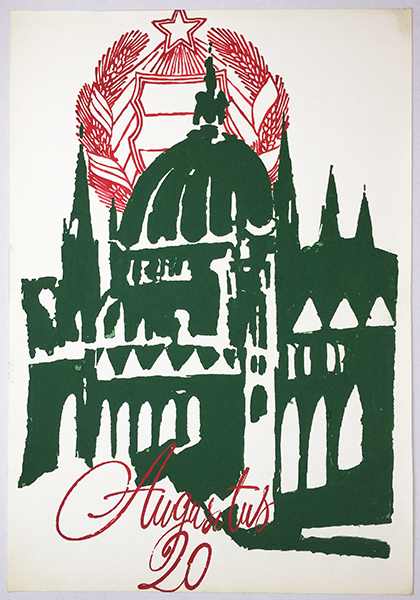
Description:
This painted poster artwork was created by Antal Gunda, a fine poster designer, for a national anniversary in the 1960s and it is connected to interesting political-historical issues.
A new period started in Hungarian poster art after the 1956 revolution. The former Rákosi-regime was replaced by the Kádár-system, and the new political situation determined the cultural changes as well. The former great expansion of political propaganda posters of the 1950s came to an end as the new political leadership realized that political issues should be avoided on streets. Along with political propaganda posters commercial posters also disappeared for a while due to the lack of products and independent clients. On the other hand, the genre of cultural poster had its heyday in the 1960s and 1970s.
Although political matters could not appear on posters of the time, there was an exception: big annual political events, state celebrations and anniversaries. These events could fit in the range of cultural events and posters of them also could function as cultural posters. These annual events generated a separated type of cultural poster design and they also gave a hard task to poster designers. The topic was the same year by year and the iconography had its own recurrent elements: waving flags, emblematic state buildings and political symbols appeared in these posters. It didn’t belong to the fancied duty of poster artists neither, but it was a help in case of a constraint of financial matters.
Compared to the average number of copies of a poster (which was about 400-4000) these posters had a high number of copies, about 10-30 000. The size of the poster was bigger than average and the quality and thickness of the paper used was also better. So this genre was a special type from several aspects.
Antal Gunda created several poster artworks for state celebrations and anniversaries. This work was created for the 20th of August which is the national and state celebration of Hungary. It is also the anniversary of the canonization of the first Hungarian king, I. Stephen, but during the Socialist era, between 1949 and 1989, it was replaced by the anniversary of the new constitution that the first political leadership of the period created.
The poster is a skillful and decorative composition of the red sign of ‘20th of August’, the green Hungarian Parliament and the red Hungarian coat of arms of the Kádár-era in front of a white background, referring to the national colours. The expressive portrayal of the image and the delicate lines of the script also contributes to the decorativeness of the poster. Even the coat of arms in the background, the political symbol of the era which wasn’t a beloved part of compositions those times, can function well visually. It also reveals Gunda’s talent that the political propagandistic character is not didactic, political issues doesn’t ruin the whole image, although the function of the political symbol is obvious. Even if the coat of arms represents the curent political ruining power, the most highlighted element of the composition is still the Hungarian Parliament, representing not only the state, but the Hungarian nation, too.
The Hungarian Parliament dates back to the end of the 19th century. There was a public tender in 1881 to find the perfect architectural design, and Imre Steindl, one of the greatest Hungarian architects of his time, was the winner with his plan. The final edifice was built until 1905 and it became the third largest Parliament building in the world, and the secong largest one in Europe. The building is located in Budapest, the capital city of Hungary, along the river Danube. Because of its location, it also became a symbol of Budapest, just as the British Parliament became symbol of London. Due to the stressed presentation of the emblematic building of the Hungarian Parliament, the poster could also function as a tourism poster of its time.
This poster artwork is a mature and decoratively painted piece from the 1960s, created by an outstanding poster artist, relating to complex issues of Hungarian history.











